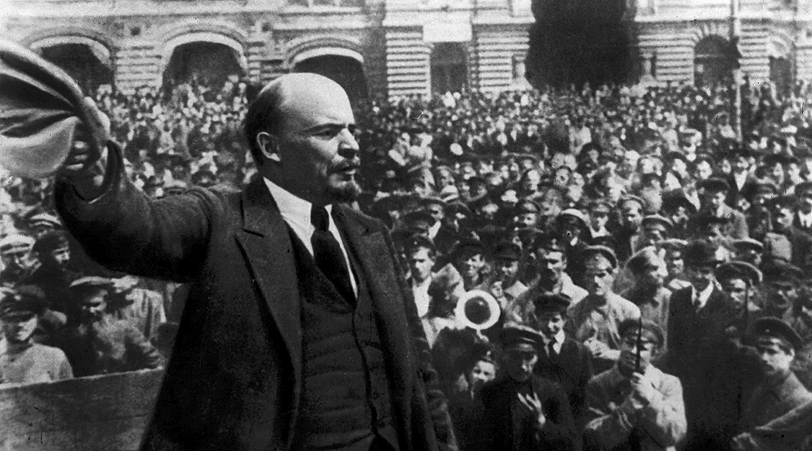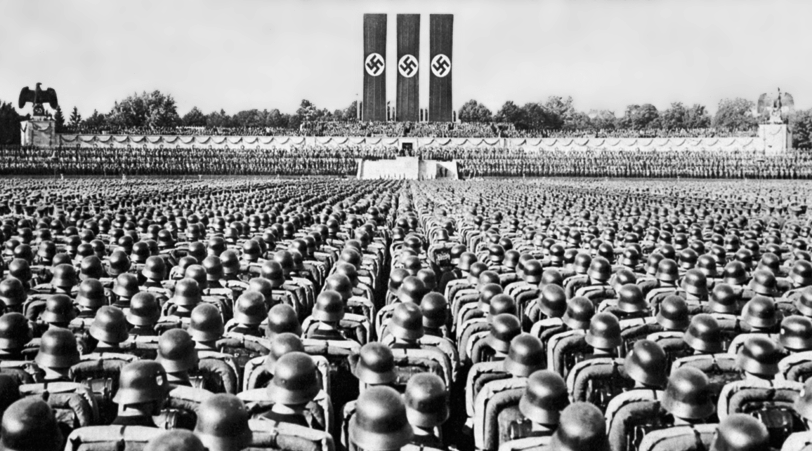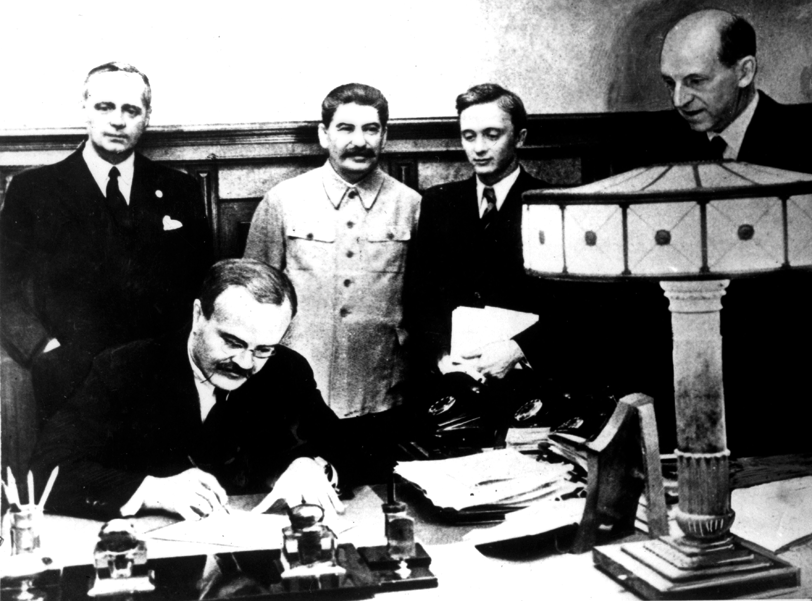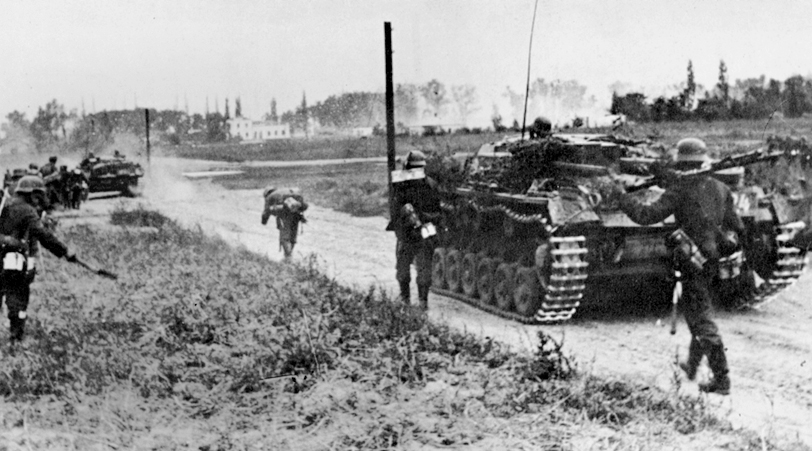The road to the Winter War
During the interwar period, the only military threat Finland faced came from the east. Hitler’s rise to power in 1933 started Europe on a path towards a large-scale war. In Finland, the national defence system was built to repel an attack by the Red Army. However, Finland would not be able to wage a war against the great power alone. The role of the Finnish Defence Forces during a war was to buy enough time for Western assistance to reach Finland. In its 1935 foreign policy, Finland ended up choosing a pro-Nordic policy. One of the goals was to commit Sweden to Finland’s defence. This goal was not achieved. Finland was forced to enter the Winter War alone, without any guarantee of assistance from the West.
Treaty of Tartu
 Lenin giving a speech at Red Square in Moscow in October 1917. Image: Ann Ronan Pictures/Print Collector/Getty Images.
Lenin giving a speech at Red Square in Moscow in October 1917. Image: Ann Ronan Pictures/Print Collector/Getty Images.
Finland declared its independence on 6 December 1917. The Bolsheviks established their position in Russia in wars fought between 1919 and 1922. The Communist Party of Finland was banned in Finland but operated in the Soviet Union. The party was founded in 1918 by rebels who had fled to Soviet Russia at the end of the Finnish Civil War.
The Western powers, i.e. the United Kingdom and France, supported Russian counter-revolutionaries. The Finnish government unofficially supported attacks by Finnish voluntary military expeditions to Soviet Karelia. Two settlements in East Karelia, Repola (Reboly) and Porajärvi (Porosozero), joined Finland. In a peace treaty signed by Soviet Russia and Finland in Tartu on 14 October 1920, Finland officially gained the area of Petsamo and gave up Repola and Porajärvi.
The peace treaty was not satisfactory to either party. The Finnish government gave its unofficial support to a volunteer military expedition that left in 1921 to support an uprising in East Karelia. Soviet forces suppressed the uprising and forced the Finnish volunteer forces to return to Finland in February 1922. The same year, the Soviet Union and Finland signed an agreement on the inviolability of the Soviet–Finnish border.
Despite the Treaty of Tartu and the agreement on the inviolability of the border, Finland considered the Soviet Union to be a political and military threat. In Finland’s opinion, the Soviet Union was constantly in breach of a document signed in connection with the Treaty of Tartu, in which the Soviet Union promised a certain level of autonomy to the population of East Karelia.
Hitler’s rise to power in Germany in 1933
 SS troops parading at a party conference of the National Socialist German Workers’ Party in Nuremberg in the late 1930s. Image: Ann Ronan Pictures/Getty Images.
SS troops parading at a party conference of the National Socialist German Workers’ Party in Nuremberg in the late 1930s. Image: Ann Ronan Pictures/Getty Images.
The Soviet Union became concerned over Germany’s rise. Soon after Adolf Hitler’s rise to power in 1933, the agreement system created in the 1920s to ensure world peace started to crumble at an accelerated pace. In the mid-1930s, Germany began to change the European borders with military force, contrary to the agreements it had previously signed. In other words, Germany was violating the agreements it had signed in the 1920s.
The rise of the Third Reich radically changed the political security situation in Europe. In the late 1930s, Germany became the greatest threat to peace. Previously, the great power considered to pose the greatest threat to peace in Europe had been the Soviet Union, which propagated a world revolution. Germany’s rise did not change the threat scenario to Finland as such. At some point, it was even thought that Germany’s rise would balance out the rapid rise of the Soviet Union as a great power with superior military strength in the 1930s.
The Soviet–Finnish Non-Aggression Pact of 1932
The Soviet Union sought to secure its western border from possible attacks by the United Kingdom or France by signing agreements with its neighbouring countries. Finland wanted to stay out of such an agreement system. Despite this, Finland entered into a non-aggression pact with the Soviet Union in 1932.
Finland declared itself to be a Nordic country in 1935
In July 1933, Finland announced its intention to join the Convention for the Definition of Aggression that had been signed in London. The convention entered into force in February 1934, after the deposition of the instrument of ratification. Drafted at the Soviet Union’s initiative, the convention was intended to supplement the Kellogg–Briand Pact, which forbade warfare. The following year, Finland declared its goal to be the adoption of a pro-Nordic policy, as it wanted to identify itself with the Scandinavian countries.
The Soviet Union’s unofficial negotiations with Finland
In April 1938, Boris Yartsev, secretary at the Soviet Embassy in Helsinki, sought an audience with the Finnish minister for foreign affairs. He wanted to initiate secret negotiations with Finland as a representative of his country. On the agenda was the threat posed by Germany. The Soviet Union anticipated that Germany would try to attack it through Finland. To prepare for this eventuality, the
Soviet Union wanted to make an agreement with Finland. However, Finland stood firmly by its neutrality. The negotiations with Yartsev ended without results in August 1938. Afterwards, the Soviet Union made other attempts to initiate unofficial negotiations.
The Molotov–Ribbentrop Pact 23 August 1939
 People’s Commissar for Foreign Affairs Molotov signing a non-aggression pact between Germany and the Soviet Union in Moscow on 23 August 1939. In the background on the left, German Foreign Minister von Ribbentrop, with General Secretary of the Central Committee of the Communist Party of the Soviet Union Stalin in the middle.
Image: Photo12/UIG/Getty Images.
People’s Commissar for Foreign Affairs Molotov signing a non-aggression pact between Germany and the Soviet Union in Moscow on 23 August 1939. In the background on the left, German Foreign Minister von Ribbentrop, with General Secretary of the Central Committee of the Communist Party of the Soviet Union Stalin in the middle.
Image: Photo12/UIG/Getty Images.
The Soviet Union and Germany invaded Poland in September 1939 and divided its territory. The division had been agreed upon in a secret protocol appended to a non-aggression pact signed in August 1939. This non-aggression pact, signed on 23 August, is known in history as the Molotov–Ribbentrop Pact, after the signatories, and as the Stalin−Hitler Pact, after the heads of state, among other names.
Germany and the Soviet Union invaded Poland in September
 German troops invade Poland on 1 September 1939. Image: Ann Ronan Pictures/Print Collector/Getty Images.
German troops invade Poland on 1 September 1939. Image: Ann Ronan Pictures/Print Collector/Getty Images.
Germany’s invasion of Poland started on 1 September. Having guaranteed Poland’s sovereignty, the United Kingdom and France declared war on Germany two days later. The Western powers did not declare war on the Soviet Union, which invaded Poland on 17 September.
Lithuania was added to the Soviet Union’s sphere of influence towards the end of September
Towards the end of September, Germany and the Soviet Union amended their agreed spheres of
influence so that Lithuania and the other Baltic states would belong to the Soviet sphere of influence, which already included Finland in accordance with the pact signed in August.
The Soviet Union established military bases in the Baltic states in October
The Soviet Union demanded and was able to persuade the Baltic states to allow it to set up military bases within their territories. On 5 October, Finland received an invitation to send negotiators to Moscow. While the negotiations began, a general mobilisation was declared in Finland under the name of additional refresher training.
Finland’s negotiations in Moscow in autumn 1939
In the negotiations conducted in Moscow, the Soviet Union demanded the right to lease a naval base on the Hanko Peninsula. Furthermore, it demanded that Finland cede the outer islands in the Gulf of Finland and for the border to be adjusted on the Karelian Isthmus and the Kalastajasaarento (Rybachy) Peninsula in Petsamo. According to the Soviet Union, these demands were based on the possibility of the United Kingdom and France invading the Soviet Union through Finland. In previous unofficial discussions, the Soviet Union had anticipated Germany to be the potential invader.
In return, the Soviet Union promised to cede large areas to Finland in East Karelia, beyond the Finnish border. Finland was only willing to accept small-scale border adjustments on the Karelian Isthmus and to cede some of the outer islands. Finland considered the leasing of the Hanko Peninsula to the Soviet Union as a naval base to be impossible. The negotiations broke down without results in November.
The Shelling of Mainila and breaking of diplomatic relations
On 26 November 1939, the Soviet Union claimed that Finland had shelled the Soviet village of Mainila from across the border with fatal consequences. Thirteen soldiers of the Red Army had been killed or injured. According to investigations carried out by Finnish border authorities, the shots had been fired by the Red Army itself. Despite this incident, many of the Finnish decision-makers still did not consider war to be imminent.
The Soviet Union broke off diplomatic relations with Finland on 29 November 1939 and started its invasion across the entire length of the Finnish–Soviet border the following morning. On the day of the invasion, the Soviet Union also bombed several locations on the Finnish home front, including Helsinki.
Ari Raunio

 SUOMEKSI
SUOMEKSI PÅ SVENSKA
PÅ SVENSKA по-русски
по-русски